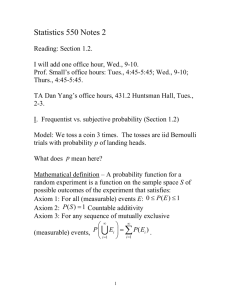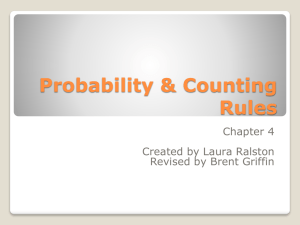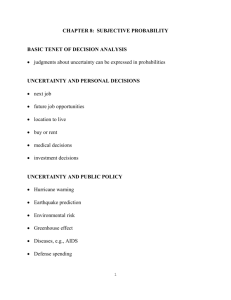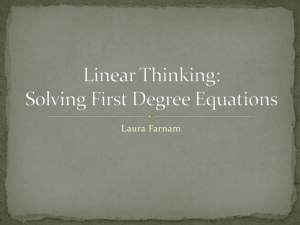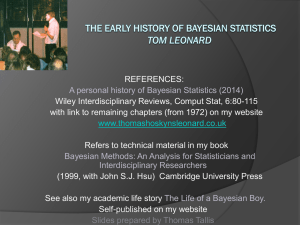Notes 2 - Wharton Statistics Department
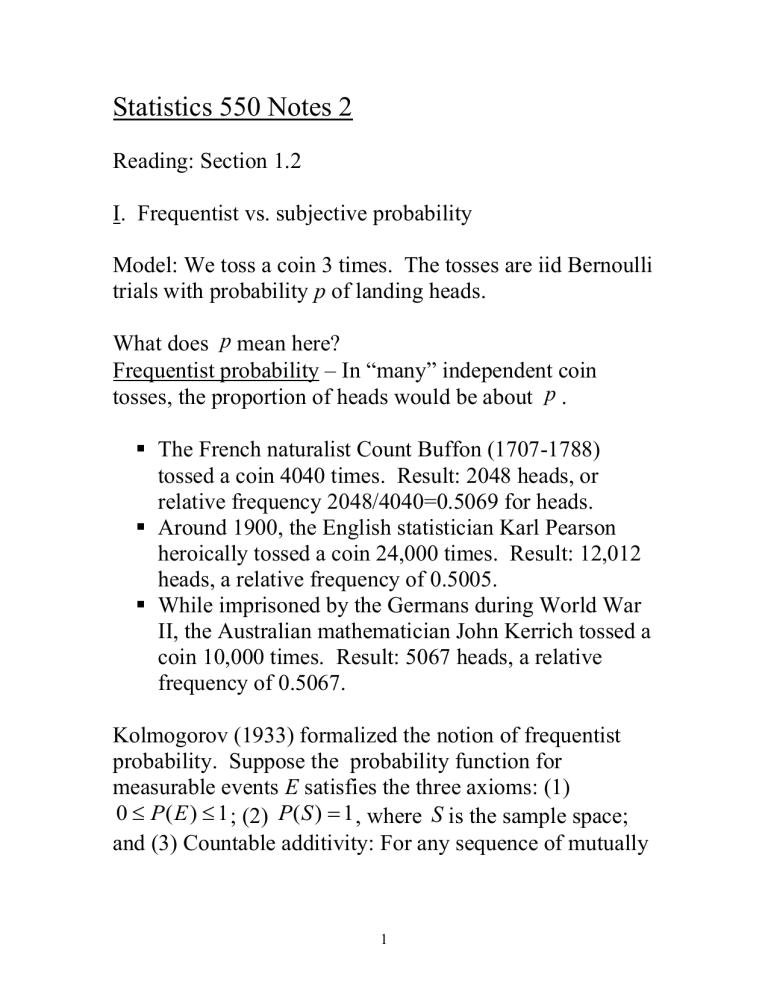
Statistics 550 Notes 2
Reading: Section 1.2
I. Frequentist vs. subjective probability
Model: We toss a coin 3 times. The tosses are iid Bernoulli trials with probability p of landing heads.
What does p mean here?
Frequentist probability – In “many” independent coin tosses, the proportion of heads would be about p .
The French naturalist Count Buffon (1707-1788) tossed a coin 4040 times. Result: 2048 heads, or relative frequency 2048/4040=0.5069 for heads.
Around 1900, the English statistician Karl Pearson heroically tossed a coin 24,000 times. Result: 12,012 heads, a relative frequency of 0.5005.
While imprisoned by the Germans during World War
II, the Australian mathematician John Kerrich tossed a coin 10,000 times. Result: 5067 heads, a relative frequency of 0.5067.
Kolmogorov (1933) formalized the notion of frequentist probability. Suppose the probability function for measurable events E satisfies the three axioms: (1)
0
( )
1 ; (2) ( )
1 , where S is the sample space; and (3) Countable additivity: For any sequence of mutually
1
exclusive events,
P
i
1
E i
i
1
P E i
)
. Suppose we have repeated independent experiments and I I
2
, are indicators of whether an event E occurs on the 1 st , 2 nd , ... trial of the experiment. Then by the strong law of large numbers
P
i n
1 n
I i
( ) as n
1
, i.e., “almost surely” the proportion of times the event occurs in repeated, independent trials will converge to the probability of the event.
Subjective (personal) probability – Probability describes our degree of belief about a statement.
“The probability that the coin lands heads is 0.5”
Subjective interpretation – This represents a person’s personal degree of belief that a toss of the coin will land heads.
Specifically, if offered the chance to make a bet in which the person will win 1
p dollars if the coin lands head and lose p dollars if the coin lands tails, the maximum amount the person would pay to play the game is p
0.5
dollars.
In general, a person’s subjective probability of an event A ,
, is the value of p for which the person thinks a bet in which she will win 1
p dollars if A occurs and lose
2
p dollars if A does not occur is a fair bet (i.e., has expected profit zero).
Subjective probability rejects the view of probability as a physical feature of the world and interprets probability as a statement about individuals state of knowledge.
“Coins don’t have probabilities, people have probabilities.”
– Persi Diaconis.
An advantage of subjective probability is that it can be applied to things about which we are uncertain which cannot be envisioned as being part of a sequence of repeated trials.
“Will the Philadelphia Eagles win the Super Bowl this year?”
“What was the temperature in Chicago at noon yesterday?
“Did Lee Harvey Oswald act alone in assassinating John F.
Kennedy?”
“What is the 353 rd digit of
?”
If I say the probability that the 353 rd digit of
is 5 is 0.2, I mean that I would consider it a fair bet for me to gain 0.8 dollars if the 353 rd digit of
353 rd digit of
is not 5.
is 5 and lose 0.2 dollars if the
II. Coherence and the axioms of probability
A rational person should have a “coherent” system of personal probabilities: a system is said to be incoherent if there exists some structure of bets such that the bettor will lose no matter what happens.
3
If a person’s system of probabilities is coherent, then they must satisfy the axioms of probability.
Example:
Proposition 1: If A and B are mutually exclusive events, then (
B )
( )
( ) .
Proof: Let
( )
p
1
,
( )
p
2
and
(
B )
p
3 be a person’s subjective probabilities for these events. Suppose that p
3 differs from p
1
p
2
. Then the person thinks that the following bets are fair: (i) a bet in which the person will win 1
p
1 dollars if A occurs and lose p
1 dollars if A does not occur; (ii) a bet in which the person will win
1
p
2 if
B occurs and lose p
2 dollars if B does not occur; and (iii) a bet in which the person will win
1
p
3 if A
B occurs and lose p
3 dollars if A
B does not occur
Say, p
3
p
1
p
2 d
( p
1
p
2
)
p
3 and let the difference be
.
A gambler offers this person the following bets: (a) the person will lose
1
p
3
d / 4 dollars if A
B occurs and win p
3
d / 4 win
1
p
d
1 if A
B
/ 4 does not occur; (b) the person will dollars if A occurs and lose p
1
d / 4 dollars if
4
1
A
does not occur; (c) the person will win p
2
d / 4 dollars if B occurs and lose p
2
d / 4 dollars if B does not occur.
According to the person’s personal probabilities, bets (a)-
(c) are all expected to yield a profit, so the person takes them.
However,
(1) Suppose A occurs. Then the person loses
1
p
3
d / 4 from bet (a), wins
1
p
d
1
/ 4 from bet (b) and loses
(1
p
1
d p
2
d
/ 4) (1
/ 4 from bet (c). The person’s profit is p
3
d / 4) ( p
2
d / 4)
( p
3
d
p
1
p
2
p
1
p
2
d
d
p
1
p
2
d / 4
(2) Suppose B occurs. The person’s profit is
(1
p
2
d / 4) (1 p
3
d / 4) ( p
1
d / 4)
( p
3
d
p
1
p
2
p
1
p
2
d
d
p
1
p
2
d / 4
(3) Suppose neither A nor B occurs. The person’s profit is
( p
3
d / 4) ( p
1
d / 4) ( p
2
d / 4)
( p
3
p
1
p
2
d
p
1
p
2
d )
p
1
p
2
3 / 4
d / 4
Thus, the gambler has put the person in a position in which the person is guaranteed to lose / 4 no matter what happens; this is sometimes called a Dutch book . So it is
5
irrational for the person to assign (
B )
( )
( ) .
A similar argument can be made that it is irrational to assign (
B )
( )
( ) .
Similar arguments can be that a rational person’s subjective probabilities should satisfy the other axioms of probability:
(1) for an event E , 0
( )
1 ; (2) ( )
1 , where S is the sample space.
Although, from Proposition 1, it is clear that a rational person’s personal probabilities should obey finite additivity
(i.e., if
E
1
, , E n are mutually exclusive events,
P
i n
1
E i
i n
1
P E i
)
), there is some controversy about additivity for a countable infinite sequence of mutually exclusive events (see J. Williamson, “Countable Additivity and Subjective Probability,”
The British Journal for the
Philosophy of Science , 1999). We assume countable additivity holds for subjective probability.
Because the usual probability axioms hold for subjective probabilities, all the results of probability hold for the subjective interpretation of probability – it is just a matter of how we interpret the probabilities.
In particular, Bayes theorem holds for subjective probability.
Let A be an event and
B
1
, , B n be mutually exclusive and
P B i
)
0 for all i . Then
6
P B j
A
P A B P B j j
) n i
1
( | i
) ( i
)
.
III. The Bayesian Approach to Statistics
Example 1 from Note 1: Shaquille O’Neal’s free throws are iid Bernoulli trials with probability p of success. In the first two games of the 2006 playoffs, Shaq made 13 of 16 free throws.
The Bayesian approach to statistics uses subjective probability and regards p as being a fixed but unknown object over which we have beliefs given by a subjective probability distribution and then uses the data to update our beliefs using Bayes rule.
Prior distribution : Subjective probability distribution about parameter vector ( p ) before seeing any data.
Posterior distribution : Updated subjective probability distribution about parameter vector ( p ) after seeing the data.
7
Bernoulli trials example: Suppose that X
1
, , X n
are iid
Bernoulli with probability of success p .
We want our prior distribution for p to be a distribution that concentrates on the interval [0,1]. A class of distributions that concentrates on [0,1] is the two-parameter beta family.
The beta family of distributions: The density function f of the beta distribution with parameters r and s is
( r s
) x r
1 x s
1
(1 ) , 0 1
The mean and variance of the Beta( r,s ) distribution are r r
s rs and
( r
1)( r
s )
2
.
See Appendix B.2 for details.
Suppose our prior distribution for p is Beta( r,s ) with density
( ) and we observe
X
1
x
1
, , X n
x n
.
Using Bayes theorem, our posterior distribution for p is
8
( |
1
, , x n
)
1
0
( ) (
1
, x n
| )
( ) ( ,
1
, x n
| )
p f x
1
, x n p
s )
p r
1
(1
p ) s
1
n
n i
1 x i
p
n i
1 x i (1
p ) n
n i
1 x i
p r
n i
1 x i (1
p ) s
i n
1 x i
The last expression is proportional to the
Beta( r
n i
1 i
i n
1 x i
) density so the posterior density for p is Beta( r
i n
1 i
n i
1 x i
).
Families of distributions for which the prior and posterior distributions belong to the same family are called conjugate families.
The posterior mean is thus equal to posterior variance is
( r r
i n
1 r s n x i
(
i n
1 x i
)( s
n i
1 r s n
2
) ( r
1) x i
and the
)
.
A valuable feature of the Bayesian approach is its ability to incorporate prior information.
Returning to our example in which Shaq made 13 out of 16 free throws in his first two playoff games, it seems too
9
optimistic based on Shaq’s past record to think that p
13 /16
.8125
.
Season
1992-93
1993-94
1994-95
FT%
.592
.554
.533
Season
2000-01
2001-02
FT%
1999-2000 .524
.513
.555
1995-96
1996-97
1997-98
1998-99
.487
.484
.527
.540
2002-03
2003-04
2004-05
2005-06
.622
.490
.461
.469
Suppose we use a prior distribution of Beta(53,47) which corresponds to a prior mean of 0.53 and a prior standard deviation of 0.05. Then the posterior distribution for
Shaq’s free throw percentage for the playoffs after seeing him make 13 out of 16 shots in his first two games is
Beta (66,50). The posterior mean is 0.569 and the posterior standard deviation is 0.046.
10
Postscript: Shaq shot 0 of 6 in the next game of the playoffs and 34.13% overall in the rest of the playoffs.
When there is more data and prior beliefs are less strong, the prior distribution does not play as strong a role.
Example 2: A cofferdam protecting a construction site was designed to withstand flows of up to 1870 cubic feet per second (cfs). An engineer wishes to compute the
11
probability that the dam will be overtopped during the upcoming year. Over the previous 25-year period, the annual maximum flood levels of the dam had ranged from
629 to 4720 cfs and 1870 cfs had been exceeded 5 times.
Modeling the 25 years as 25 independent Bernoulli trials with the same probability p that the flood level will exceed
1870 cfs and using a uniform prior distribution for p (which corresponds to a Beta (1,1)), the prior and posterior densities are
12
IV. Bickel and Doksum’s perspective on Bayesian models.
(a) Bayesian models are useful as a way to generate statistical procedures which incorporate prior information when appropriate.
However, statistical procedures should be evaluated in a frequentist (repeated sampling) way:
13
For example, for the iid Bernoulli trials example, if we use the posterior mean with a uniform prior distribution to estimate p , i.e.,
1
n
n
i
1
1 x i
, then we should look at how this estimate would perform in many repetitions of the experiment if the true parameter is p for various values of p . More to come on this frequentist perspective in
Chapter 1.3.
(b) We can view the parameter as random and view the
Bayesian model as providing a joint probability distribution on the parameter and the data.
Consider the Bayesian model we put a prior distribution
P
P on
= {
.
P
,
}
where
We can view the parameter
as being random and view the Bayesian model as providing a joint distribution for the parameter and the data
X ) , e.g., if the data
X
1
, , X n
are iid Bernoulli trials with probability p of success and the prior distribution for p is
Beta( r,s ), then the joint probability distribution for p X
1
, , X n
)
is generated by:
1. We first generate p from a Beta( r,s ) distribution.
2. Conditional on p , we generate
X
1
, , X n
iid Bernoulli trials with probability p of success.
14
